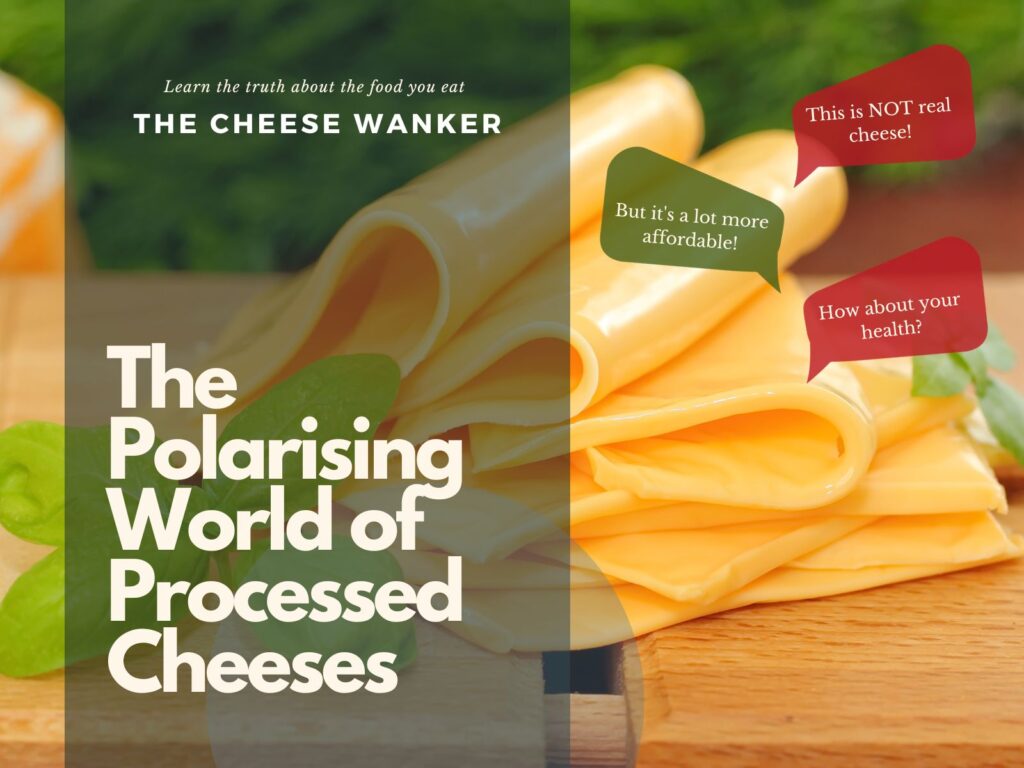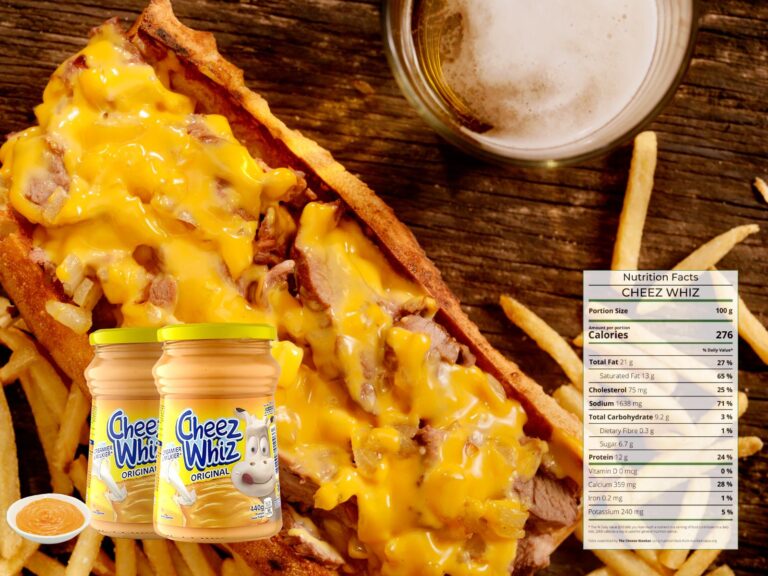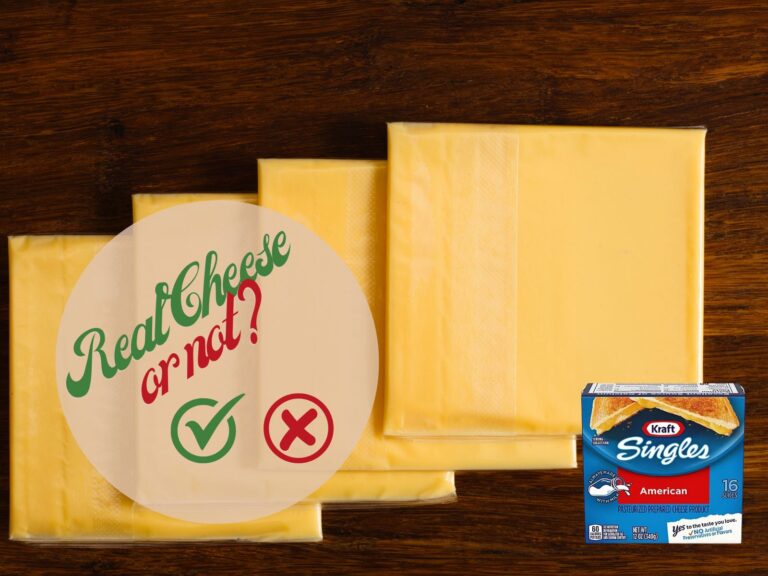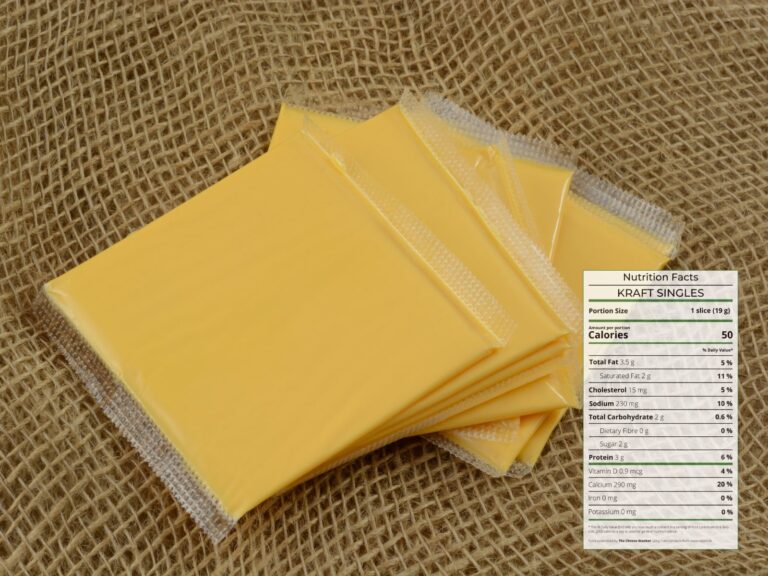In the diverse realm of cheese, there’s room for both purists who appreciate artisanal varieties and those who value convenience. Processed cheeses, though often frowned upon, offer a unique blend of affordability and texture that has earned them a special place in our kitchens. In this journey through the world of processed cheeses, we’ll explore their various forms, analyse their nutritional characteristics, and compare them to their unprocessed counterparts.

SEE ALSO: What is the official definition of real cheese? →
What are processed cheeses?
Processed cheese, also known as process cheese, is a type of cheese product made from natural cheese and other ingredients. It undergoes specific processing steps to alter its texture, meltability and shelf life.
The key characteristics of processed cheese include its smooth and uniform consistency, ability to melt evenly and long-lasting freshness.
Different types of processed cheeses
According to the U.S. Food and Drug Administration (FDA), processed cheeses fall into three main categories:
1. Pasteurized process cheese
This is a cheese product made by crumbling and mixing one or more varieties of cheese with an emulsifying agent, resulting in a homogeneous mass. Optional ingredients can be added to enhance flavour and texture. But it must contain at least 51% cheese by weight.
Click here for the complete FDA file on pasteurized process cheese.
2. Pasteurized process cheese food
This type of product is similar to pasteurized process cheese, but it may also include other dairy ingredients. According to the FDA, it must contain at least 51% cheese by weight and typically has a moisture content not exceeding 44%.
Read more about pasteurized process cheese food in the FDA file here.
3. Pasteurized process cheese spread
Finally, this type of processed cheese incorporates emulsifying agents and optional ingredients for a spreadable consistency at 21°C (70°F). Moreover, it must contain at least 51% cheese by weight and typically has a moisture content ranging from 44% to 60%.
You can find the complete FDA file on pasteurized processed cheese spreads here.
What about pasteurized cheese products?
The FDA doesn’t establish a specific standard of identity for either “pasteurized prepared cheese product” or “pasteurized process cheese product”. Interestingly, such labels are commonly found on various Kraft and store-branded singles in the United States.
This labelling strategy allows manufacturers to avoid potential accusations of false advertising. Consequently, products with these designations have the flexibility to incorporate milk protein concentrate (MPC) into their formulations, even though the FDA prohibits the use of MPC in processed cheese.
The primary incentive behind this labelling is the manufacturers’ desire to use cost-effective imported MPC as a partial cheese substitute.
Following an FDA Warning Letter addressing Kraft’s use of MPC in late 2002, some Kraft Singles, previously labelled as “pasteurized process cheese food”, were rebranded as “pasteurized prepared cheese product”.
Likewise, Velveeta transitioned from “pasteurized process cheese spread” to “pasteurized prepared cheese product”. And Easy Cheese changed to “pasteurized cheese snack”.
This relabelling allowed manufacturers to adapt to regulatory concerns while continuing to offer their products to consumers.
How does processed cheese compare to real cheese?
While processed cheese products offer convenience and affordability, they differ from real cheese in several ways:
Ingredients: Real cheese typically consists of milk, enzymes and bacteria, without emulsifiers or additives.
Flavour: Natural cheeses offer a wide range of flavours and aromas, whereas processed cheeses have a milder taste.
Texture: Natural cheeses come in various textures, from crumbly Feta to creamy Brie, while processed cheeses have a consistent texture.
Nutritional analysis: Processed cheeses vs real cheeses
While both processed cheese and real cheese have their place in the world of culinary delights, their nutritional profiles differ significantly. Processed cheese often provides a lower-calorie, lower-fat option, but it may contain higher levels of sodium and additives.
Real cheese, on the other hand, offers a richer source of essential nutrients like calcium and protein but is higher in calories and saturated fat.
The choice between processed and real cheese ultimately depends on your dietary preferences, nutritional needs and culinary goals. Incorporating both into your diet in moderation can provide a well-rounded and enjoyable cheese experience.
Always check product labels to make informed choices based on your health and taste preferences.
Why are processed cheeses more affordable?
Processed cheeses are generally cheaper than real, unprocessed cheese. Several factors contribute to their lower cost:
Lower cheese content
Both process cheese food and process cheese product contain less real cheese than their unprocessed counterparts. Real cheese can be relatively expensive, so reducing the cheese content lowers the production cost.
Additives and fillers
Furthermore, these products often contain additives, fillers and other ingredients that are less expensive than real cheese. These additives help achieve the desired texture, consistency and flavour without relying solely on costly cheese.
Processing and shelf life
The manufacturing process for process cheese involves blending, emulsifying and melting cheese. Of course, this is more cost-effective than ageing and curing real cheese.
Additionally, the processing techniques extend the shelf life of these products, reducing potential waste and costs associated with spoilage.
Mass production
Process cheese foods and products are often produced on a large scale, which can lead to cost savings through economies of scale.
While these products are more budget-friendly, it’s important to consider the trade-offs. They may not offer the same depth of flavour, nutritional value or texture as real cheese.
Examples of processed cheeses
Processed cheese comes in various forms, each tailored to specific culinary applications and consumer preferences. Here are examples of each type of processed cheese:
1. Pasteurized process cheese
American Cheese: This is one of the most well-known types of processed cheese. According to the FDA, American Cheese can comprise of Cheddar, Colby, Granular Cheese and/or Washed Curd Cheese. It is often used in burgers, sandwiches and grilled cheese.
Process Swiss Cheese: Processed Swiss cheese is typically a mixture of deli Swiss and Gruyère cheeses. It is popular for its mild, nutty flavour. And is often used in classic dishes like Reuben sandwiches and cheeseburgers.
2. Pasteurized process cheese food
Sandwich-Mate Singles: Marketed as “Imitation Pasteurized Process Cheese Food”, this brand of Singles is high in calcium and cholesterol free. However, it is high in sodium and has almost no protein content.
Williams Cheese Smoked Swiss Block: This block of pasteurised process cheese food is hickory smoked. The cheese ingredients include Swiss, Cheddar and Colby.
3. Pasteurized process cheese spread
Kraft Old English Spread: Thanks to its very high fat and sodium contents, this spread has a hugely appealing texture and flavour profile. But, for this same reason, it is not the healthiest of choices.
Amish Country Limburger Spread: This hugely popular Amish spread is made using Limburger cheese. So, you can expect some of that savoury and meaty goodness to shine through.
Conclusion
In the world of cheese, processed cheeses have carved out a unique place. While they may not share the same artisanal allure as their natural counterparts, they offer convenience, versatility and affordability that have made them kitchen staples for many.
While processed cheeses often receive criticism for their ingredient lists and manufacturing processes, they continue to be beloved for their creamy meltability, consistent texture and ease of use.
It’s important to recognise that processed cheeses, like any food, have their place in a balanced diet. Of course, moderation is key. And understanding the differences in nutrition between processed and natural cheeses empowers you to make informed choices.
So, the next time you’re faced with the choice between processed cheese and its natural counterpart, consider your culinary needs, budget and dietary preferences.
How do you like to use processed cheeses? Let us know in the comments below.



